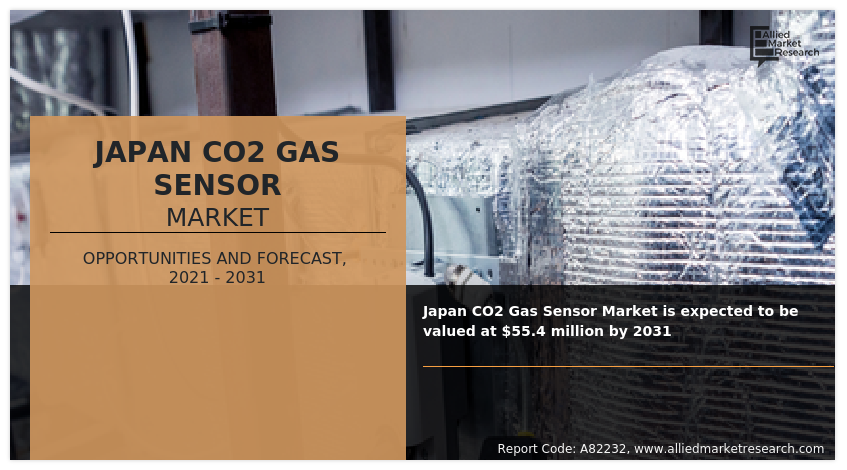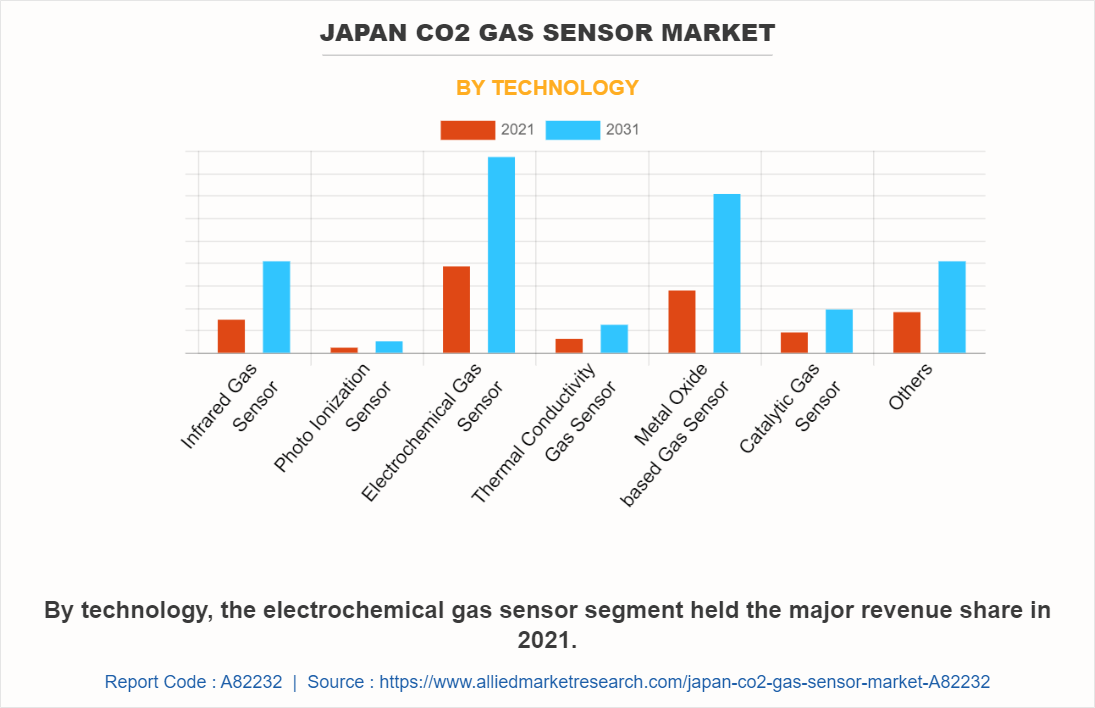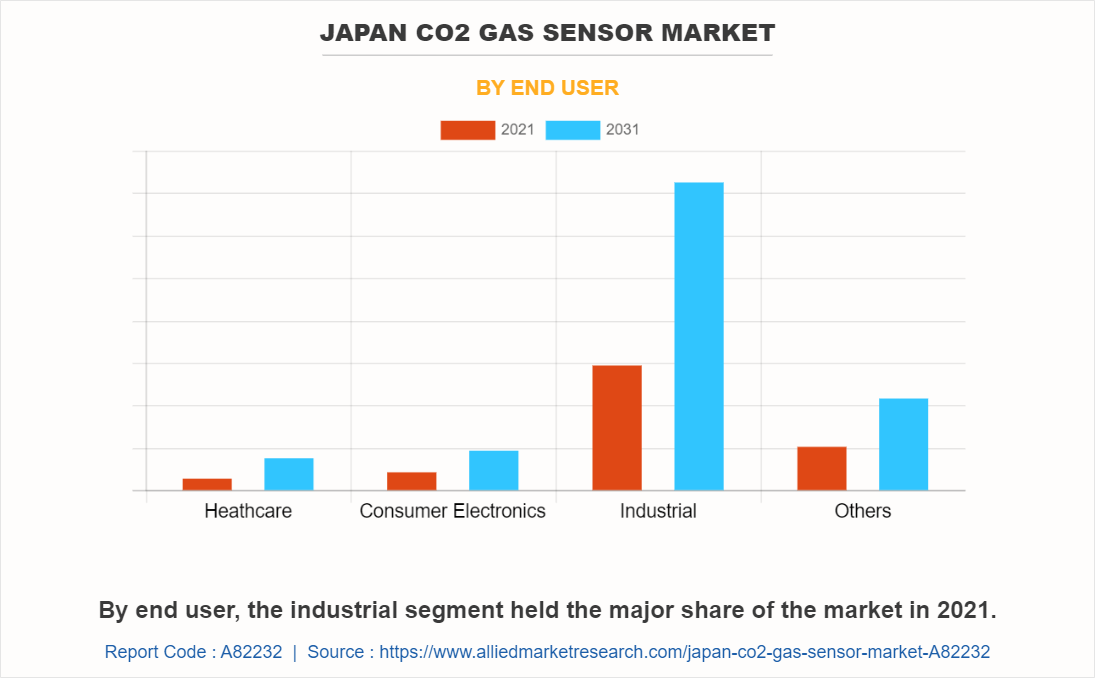The Japan CO2 gas sensor market is experiencing substantial growth during the projection period. This is attributed to rise in global concern regarding climate change and air quality. As the world becomes more aware of the adverse effects of CO2 emissions, there is rise in demand for efficient gas sensors that monitor and control CO2 levels. This heightened environmental consciousness has led to government regulations and initiatives aimed at reducing carbon footprints, which in turn has prompted industries and consumers to adopt CO2 gas sensors. Moreover, the market's growth has been significantly fueled by technological advancements. CO2 sensors have become more accessible to a wider range of applications due to innovations in sensor technologies, making them more accurate, compact, and cost-effective. In addition, infrared gas sensors have seen improvements in accuracy and response time, expanding their utility in various industries.

Furthermore, the increase in the utilization of IoT and connected devices has enhanced the requirement for CO2 gas sensors. These sensors are incorporated into intelligent home systems, HVAC systems, and industrial automation, enabling continuous monitoring and regulation of indoor air quality. This interconnectivity has emerged as a significant catalyst in the market. On the other hand, the Japan CO2 gas sensor market faces several challenges, including high cost of high-precision sensors, which limit their adoption in smaller businesses or households. Despite advancements that have made sensors more cost-effective, the cost factor remains a significant restraint in the market. In addition, regulatory hurdles pose challenges for both manufacturers and end-users, as compliance with various environmental and safety regulations is complex and costly. These regulations vary by industry and region, adding a layer of complexity to the market.

However, in the realm of CO2 gas sensors, the Japan market presents numerous opportunities and future trends that hold the potential for growth and innovation. Primarily, the integration of CO2 sensors in healthcare emerges as a promising area. The ongoing COVID-19 pandemic has emphasized the significance of air quality in healthcare environments. Consequently, hospitals, clinics, and residential care facilities are progressively incorporating CO2 sensors to guarantee adequate ventilation and air quality. This development creates a significant opportunity for market expansion. Moreover, the consumer electronics industry is witnessing a growing inclination toward sustainability, owing to an increase in awareness among consumers about environmental conservation. To cater to this demand, smart home systems are now equipped with CO2 sensors, enabling homeowners to keep a check on their carbon emissions. This trend is predicted to gather pace in the near future, leading to a surge in the demand for CO2 sensors in this particular segment.

Furthermore, Japan is renowned for its rigorous environmental regulations, which present favorable prospects for CO2 sensor manufacturers to offer compliant solutions and gain a competitive advantage in the market. In addition, the government's commitment to achieving carbon neutrality and promoting clean energy sources is expected to drive the demand for CO2 sensors across diverse sectors such as energy production, transportation, and manufacturing. The market is segmented into technology, end user. On the basis of technology, the market is classified into infrared gas sensor, photo ionization sensor, electrochemical gas sensor, thermal conductivity gas sensor, metal oxide-based gas sensor, catalytic gas sensor, and others. Depending on end user, it is fragmented into healthcare, consumer electronics, industrial, and others. Porter’s five forces analysis analyzes the competitive scenario of the Japan CO2 gas sensor market and the role of each stakeholder. These forces include the bargaining power of suppliers, bargaining power of buyers, threat of substitutes, threat of new entrants, and competitive rivalry.
The CO2 gas sensor market faces a limited threat of new entrants, primarily due to substantial capital investments required for R&D, manufacturing, and regulatory compliance. Established players in the market often enjoy advantages stemming from economies of scale and well-established customer relationships. The bargaining power of suppliers on the market is contingent upon the specific technology employed in CO2 sensors. Suppliers dealing in rare materials or advanced semiconductor components possess considerable bargaining power. Nevertheless, the presence of multiple suppliers and the emergence of alternative technologies help alleviate this power.
The impact of market demand and availability of alternatives significantly affects the bargaining power of buyers. In industries with numerous competing manufacturers, buyers possess greater negotiation leverage. Conversely, in specialized sectors with limited alternatives, buyers have restricted bargaining power. In the CO2 gas sensor market, the threat of substitutes poses a minimal threat due to sensors' distinctive design for specific applications. Although alternative technologies such as chemical color-changing sensors may exist, they often lack the precision and versatility of CO2 gas sensors. The competitive rivalry is intense, with multiple manufacturers vying to acquire a portion of the market. Key elements in attaining a competitive advantage include differentiated products, brand recognition, and technological advancements.
A comprehensive evaluation of the Japan CO2 gas sensor market is conducted through a SWOT analysis, which examines the strengths, weaknesses, opportunities, and threats. The market's strengths include the utilization of advanced sensor technologies, such as infrared and electrochemical sensors, which offer high precision and dependability. In addition, the market is experiencing a surge in demand for CO2 sensors due to a rise in environmental concerns. Furthermore, technological advancements are driving product improvements and market expansion. The adoption of the product is limited to smaller businesses and households due to cost factors. Manufacturers and end-users may face complex and costly regulatory compliance. In addition, profit margins are affected by intense competition among manufacturers, which is one of the major weaknesses of the market. There are various opportunities available for the integration of CO2 sensors in healthcare and smart home systems.
Key Benefits For Stakeholders
- Enable informed decision-making process and offer market analysis based on current market situation and estimated future trends.
- Analyze the key strategies adopted by major market players in Japan CO2 gas sensor market.
- Assess and rank the top factors that are expected to affect the growth of Japan CO2 gas sensor market.
- Top Player positioning provides a clear understanding of the present position of market players.
- Detailed analysis of the Japan CO2 gas sensor market segmentation assists to determine the prevailing market opportunities.
- Identify key investment pockets for various offerings in the market.
Japan CO2 Gas Sensor Market Report Highlights
| Aspects | Details |
| Forecast period | 2021 - 2031 |
| Report Pages | 74 |
| By Technology |
|
| By End User |
|
| Key Market Players | Figaro Engineering Inc., SGX Sensortech, HORIBA, Ltd., Amphenol Corporation, Nissha Co., Ltd., ELT Sensor Corp., Aeroqual Ltd., SenseAir AB, Dynament Ltd, Telaire |
The Japan CO2 Gas Sensor Market is estimated to reach $55.4 million by 2031
Figaro Engineering Inc., HORIBA, Ltd., Nissha Co., Ltd., Telaire, Aeroqual Ltd., Amphenol Corporation, SenseAir AB, ELT Sensor Corp., SGX Sensortech, and Dynament Ltd. are the leading players in Japan CO2 Gas Sensor Market
1. Enable informed decision-making process and offer market analysis based on current market situation and estimated future trends.
2. Analyze the key strategies adopted by major market players in japan co2 gas sensor market.
3. Assess and rank the top factors that are expected to affect the growth of japan co2 gas sensor market.
4. Top Player positioning provides a clear understanding of the present position of market players.
5. Detailed analysis of the japan co2 gas sensor market segmentation assists to determine the prevailing market opportunities.
6. Identify key investment pockets for various offerings in the market.
Japan CO2 Gas Sensor Market is classified as by technology, by end user
Loading Table Of Content...
Loading Research Methodology...



